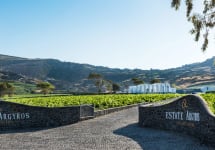Estate Argyros Vinsanto 12 Year (500ML) 2003
-
Robert
Parker - Decanter



Product Details
Your Rating
Somm Note
Winemaker Notes
The grapes used for Estate Argyros Vinsanto are harvested from the oldest parcels of the estate. Located in Episkopi, the average age of the vines is 150 years old, with some vines over 500 years old. Yields are extremely low. The ungrafted vines are basket pruned, and dry farmed. Grapes are hand-picked in August.
Hand-picked grapes are spread out on the ground to sundry for 12-14 days. The raisinated grapes are then pressed, and undergo fermentation for approximately 2 months. The wine is aged in French oak barrels for 12 years, then bottle-aged for another year prior to release.
An exceptional dessert wine, with prolonged oak aging for greater depth and character. Rich amber in color, this vinsanto is rich with flavors of raisins, figs, and butterscotch, yet balanced, cut by a still vibrant acidity.
Professional Ratings
-
Robert Parker's Wine Advocate
The 2003 Vinsanto 12 Years Barrel Aged is the traditional blend (80% Assyrtiko, 10% each of Athiri and Aidani), aged in used French oak for 144 months. It comes in at 275 grams of residual sugar, 7.22 of total acidity and 13.5% alcohol. The grapes, from very old vineyards (200 years, minimum, the winery says) in Episkopi, were sun-dried for 12 days. The rapidly increasing price references a 500-milliliter bottle, but it is fair to note the very low yield from old vines and the 12 years of aging. It's also fair to note the great quality. Concentrated and long on the gripping finish, this might be a richer and deeper version than some years, but the complexity and the power are still impressive as well. Tasted the next day, it seemed tighter and more focused—not quite as sexy but better structured and more intense. On the first pour, it was lush and friendly, but overnight and two days later it became something of a powerhouse.
-
Decanter
Exuberant and pure, layered with complexity and grace. Notes of coffee beans, jammy fig and dried apricot. Creamy fruit and sweetness are lifted by its minerality.
Other Vintages
2004-
Robert
Parker
-
Robert
Parker -
Wine &
Spirits




Founded in 1903, the Argyros Estate is located on the island of Santorini, famed for its spiraling vines and white washed churches. In 1950, the Argyros vineyards were passed down to the founder’s son, who tripled the estate from 5 to 15 acres. Yiannis Argyros, the third-generation owner of the estate who took over in 1974, began looking beyond the local market for his wines. The inorganic soil of the island of Santorini is naturally immune to Phylloxera and many other vineyard pests, reducing the need for synthetic herbicides & pesticides. Estate Argyros practices sustainable viticulture, using composted grape must as fertilizer, and plowing the vineyards with mules.
The estate vineyards are located primarily in Episkopi and Pyrgos, which are prime locations for Assyrtiko. The ungrafted vines range in age from 30 to over 150 years, and are trained into basket-shaped bowls, a traditional technique called ""kouloura"". Today, Mathew Argyros, the fourth generation of family winemakers, continues his father's legacy by making legendary wines from Assyrtiko and other indigenous Santorinian varietals, using traditional techniques.

Apart from the classics, we find many regional gems of different styles.
Late harvest wines are probably the easiest to understand. Grapes are picked so late that the sugars build up and residual sugar remains after the fermentation process. Ice wine, a style founded in Germany and there referred to as eiswein, is an extreme late harvest wine, produced from grapes frozen on the vine, and pressed while still frozen, resulting in a higher concentration of sugar. It is becoming a specialty of Canada as well, where it takes on the English name of ice wine.
Vin Santo, literally “holy wine,” is a Tuscan sweet wine made from drying the local white grapes Trebbiano Toscano and Malvasia in the winery and not pressing until somewhere between November and March.
Rutherglen is an historic wine region in northeast Victoria, Australia, famous for its fortified Topaque and Muscat with complex tawny characteristics.

